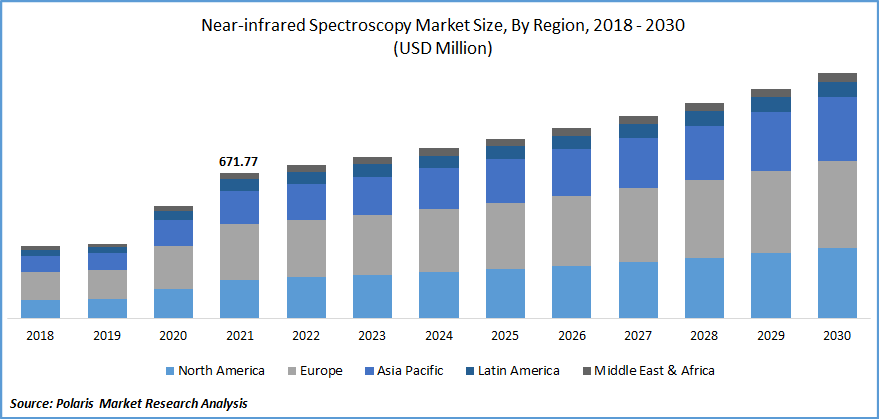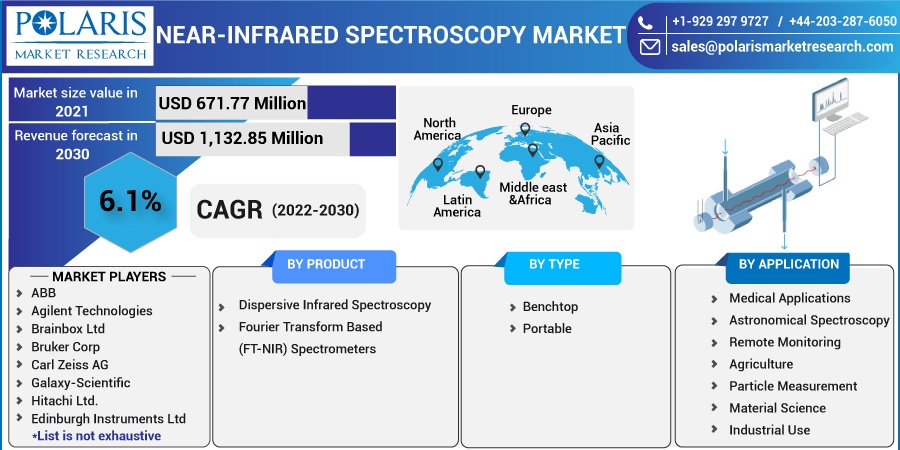
Near-infrared Spectroscopy Market Share, Size, Trends, Industry Analysis Report
By Product (Dispersive Infrared Spectroscopy, Fourier Transform Based (FT-NIR) Spectrometers); By Type; By Application; By Region; Segment Forecast, 2022 - 2030
- Published Date:Sep-2022
- Pages: 112
- Format: PDF
- Report ID: PM2605
- Base Year: 2021
- Historical Data: 2018-2020
Report Outlook
The global near-infrared spectroscopy market was valued at USD 671.77 million in 2021 and is expected to grow at a CAGR of 6.1 % during the forecast period. The market is expanding due to the adoption of near-infrared spectroscopy in biotechnology, insect detection, proteomic research, crime detection, and forensic lab applications.

Know more about this report: Request for sample pages
Many sectors, including chemicals, cosmetics, pulp and paper, pharmaceuticals, petrochemicals, polymer manufacture, and palm oil, can benefit from the use of NIRS. The simple multiparameter analysis provided by NIRS of the important parameters required for efficiently monitoring the refining of hydrocarbons is also frequently used in quality control applications dealing with jet fuel, crude oil, or diesel blends.
NIRS has the ability to evaluate multiple parameters simultaneously; many NIR users report significant time and cost reductions compared to traditional wet chemical techniques. In order to stop diseases, rising from spoiled and contaminated food, players in the food and beverage business are required to test the safety standards of their products on a regular basis.
In quality control and quality assurance procedures, where the main objective is to precisely identify samples' chemical and physical attributes, near-infrared spectroscopy is frequently used in the food and beverage sector and uses near-infrared spectrometers (NIRS) extensively to monitor food quality.
It is mostly used to test food goods for fermentation, tastes, and smells. Through safety monitoring, it can also be utilized to find adulteration in food products. During the forthcoming period, there will be an increase in demand for NIRS due to the growing significance of food safety evaluation and control.
In addition, there are several small to mid-sized businesses in the developing and niche industry of near-infrared spectroscopy. As part of Good Manufacturing Practices (GMP) for pharmaceutical producers, centrally controlled laboratories test samples using NIR analyzers. Several regulatory authorities, including the U.S.-FDA, the Ministry of Health, National Medical Stores & NDA, and Health Canada, use NIR spectroscopy as one of their methods to assess pharmaceutical authentication.
The industry is growing as a result of the wide range of applications, product line flexibility, and adaptability, as well as the increased use of NIR spectroscopy to provide chemical and physical information.
 Know more about this report: Request for sample pages
Know more about this report: Request for sample pages
Industry Dynamics
Growth Drivers
The COVID-19 outbreak had a positive impact on the pharmaceutical industry's needs. However, it is anticipated that industry upheavals in sectors like chemical, food & beverage, and electronics & semiconductors may negatively affect the growth rate.
NIR spectrometry usage has increased as a result of the COVID-19 pandemic for determining the authenticity of COVID-19 vaccines. The researchers asserted that NIR spectrometry was a quick and effective technique to authenticate COVID-19 vaccines in the study after showing that it could be used to assess COVID-19 injections. However, new installations noticed a drop during the outbreak.
The market for near-infrared spectroscopy is expanding significantly as a result of the increased number of chronic diseases and related medical treatments. The near-infrared spectroscopy market is expected to grow in the upcoming years due to the rising deployment of modern healthcare facilities in emerging nations.
Report Segmentation
The market is primarily segmented based on Product , type, Aplication, and region.
|
By Product |
By Type |
By Application |
By Region |
|
|
|
|
Know more about this report: Request for sample pages
The FT-NIR spectrometers market segment led and held the biggest share in 2021.
The segment is anticipated to continue growing at the highest rate and hold the top spot during the anticipated timeframe. The time-consuming, wet chemical procedures and chromatographic techniques can be effectively replaced by FT-NIR. It is quick and reliable for quantitative and qualitative analysis because it is non-destructive and does not require sample preparation or harmful chemicals. FT-NIR spectroscopy is frequently utilized for quality control purposes in the chemical, food, pharmaceutical, and agricultural industries.
The dispersive near-infrared spectroscopy market is expected to grow at the second-fastest rate throughout the period as a result of its growing acceptance in the agriculture industry. The device uses monochromators to collect spectral data and has mostly been used to measure grains and grain products.
The benchtop type segment dominated the market and had the biggest share in 2021.
It is expected that the segment will continue to lead the market throughout the projection period due to its high accuracy and ability to identify different substances within the pharmaceutical sector. The benchtop's longer lifespan and decreased frequency of purchase by businesses mean that it is anticipated to have a low volume of sales and a higher profit margin. Due to the benefits that benchtop instruments provide, like enhanced workflow, minimal space requirements, and reduced maintenance needs, a large fraction of this market can be attributed to them.
The portable type is predicted to grow at the fastest rate during the projection period. The growing concerns about the quality of pharmaceuticals in low- and middle-income nations, as well as purposeful attempts by international organizations to establish a strong regulatory system for quality control, are the key forces driving this market's expansion.
The particle measurement dominated the market and had the largest market share in 2021.
Studying particles in many areas, which included pharmaceutical drugs, is covered in this segment. NIR spectroscopy is used in several guidelines around the world to support different analytical methods and cGMP criteria.
Some of the properties of NIR as an analytical method for pharmaceutical product development and drug substance include instrument qualification, methodology validation, and sample design of experiments. Furthermore, over the estimated time, it is expected that non-healthcare segments will grow more quickly.
Additionally, near-infrared NIR spectrometers are used in the food and agriculture industries to evaluate the composition and quality of food products. They are utilized to check for contaminants, moisture content, and other aspects linked to food.
Europe is expected to dominate and witness the fastest growth over the forecast period
This biggest percentage can be attributable to the region's presence of significant pharmaceutical producers and the area regulatory authorities' endorsement of NIR spectroscopy. The regulatory authorities' guidelines help with the creation, validation, and application of NIR-based analytical techniques for evaluating the drug and its constituent parts.
Since Japan and India have made considerable advancements in the application of near-infrared spectroscopy technology, the Asia Pacific region is expected to grow at the fastest rate overall during the forecast period. Because of the rising incidence of cancers and cardiovascular disorders in the region, as well as growing concerns about food contamination, the Asia Pacific near-infrared spectroscopy market is anticipated to grow at the fastest rate in terms of revenue over the course of the upcoming years.
Competitive Insight
Some of the major players operating in the global market include ABB, Agilent Technologies; Brainbox Ltd; Bruker Corp; Carl Zeiss AG; Galaxy-Scientific; Hitachi Ltd., Edinburgh Instruments Ltd; Horiba Ltd.; JASCO International Co.; KPM Analytics; Lumex Instruments; Malvern Panalytical Ltd; Metrohm AG; Oxford Instruments; OSRAM Opto Semiconductors GmbH; PerkinElmer Inc.; Shimadzu Corporation ; Thermo Fisher Scientific Inc.
Recent Developments
March 2022: A multi-year partnership agreement has been reached by KPM Analytics Inc. and AB Vista, the feed additives business of AB Agri Limited. The new licensing agreement increases the calibration development, customization, and support operations between the two businesses and solidifies the strategic partnership between KPM Analytics and AB Vista.
March 2020: A mobile near-infrared (NIR) spectroscopy solution has been released, according to trinamiX GmbH (Ludwigshafen, Germany), a fully owned subsidiary of BASF SE. trinamiX's innovative Mobile Near Infrared (NIR) Spectroscopy Solutions assist in enhancing immediate decision-making.
Near-infrared Spectroscopy Market Report Scope
|
Report Attributes |
Details |
|
Market size value in 2021 |
USD 671.77 million |
|
Revenue forecast in 2030 |
USD 1,132.85 million |
|
CAGR |
6.1 % from 2022 - 2030 |
|
Base year |
2021 |
|
Historical data |
2018 - 2020 |
|
Forecast period |
2022 - 2030 |
|
Quantitative units |
Revenue in USD million and CAGR from 2022 to 2030 |
|
Segments covered |
By Product, By Type, By Application, and By Region |
|
Regional scope |
North America, Europe, Asia Pacific, Latin America; Middle East & Africa |
|
Key companies |
ABB, Agilent Technologies; Brainbox Ltd; Bruker Corp; Carl Zeiss AG; Galaxy-Scientific; Hitachi Ltd., Edinburgh Instruments Ltd; Horiba Ltd.,; JASCO International Co.; KPM Analytics; Lumex Instruments; Malvern Panalytical Ltd; Metrohm AG; Oxford Instruments; OSRAM Opto Semiconductors GmbH; PerkinElmer Inc.; Shimadzu Corporation ; Thermo Fisher Scientific Inc. |
